信抽样及抽样定理
通信原理抽样定理

通信原理抽样定理通信原理抽样定理是一项重要的通信技术原则,它是指对于一个连续时间信号进行抽样时,必须按照一定的规则进行抽样,才能够准确地还原出原始信号的信息。
本文将对通信原理抽样定理进行详细的解释。
一、连续信号与离散信号在通信系统中,信号通常被分为连续信号和离散信号两种类型。
连续信号是指在时间上呈连续变化的信号,例如声音信号、视频信号等。
而离散信号则是指信号经过采样后,在时间上呈现出间断的特点,例如数字音频、数字图像等。
二、抽样定理的原理通信原理抽样定理是基于傅里叶变换的原理得出来的。
傅里叶变换是将时域信号转化为频域信号的一项数学技术。
在信号的频域表示中,信号的频率为离散的,而抽样定理是建立在这个基础上的。
在进行信号采样时,必须按照一定的规则进行采样,这样才能够准确地还原出原始信号。
通常采用的规则是在一段时间内等间隔地进行采样,所采集的数据称为采样数据。
一个连续信号在被采样时,若满足采样频率大于两倍的信号最高频率,则可以通过采样信号得到原始信号的全部信息。
这就是通信原理抽样定理的核心原理。
三、抽样频率通信原理抽样定理中,抽样频率的选择对于信号的还原具有重要的影响。
一般来说,抽样频率越高,得到的离散信号就越接近原始连续信号,还原的信息也就越准确。
但是,过高的抽样频率会导致信号处理所需的计算量增加和数据存储量增大,同时也会增加系统成本。
抽样频率的选择既要考虑信号本身的特点,还要考虑计算量和存储量等实际因素。
在各种应用中,针对不同类型的信号和系统要求,通常计算出最优的抽样频率。
四、抽样信号的重构在实际应用中,原始连续信号往往是由离散信号采样得到的。
还原连续信号则需要通过离散信号进行重构。
重构方法有多种,其中常用的是插值法。
插值法是一种基于已知点的数值计算方法,用于估算未知点坐标的数值。
在进行插值重构时,需要确定合适的插值函数和插值点。
插值函数通常选用多项式函数,并尽可能将插值点均匀、密集地分布在原信号的采样区间内。
信号抽样与抽样定理
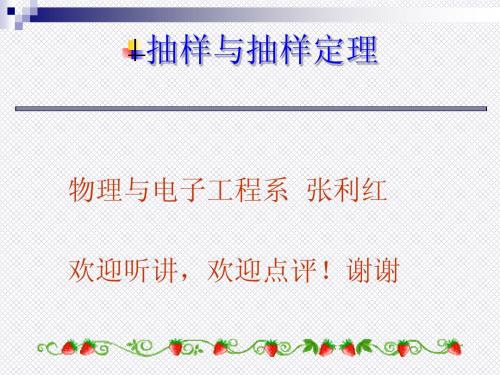
− nω
s
)
F (ω − n ω
)
矩形脉冲抽样——频谱结构 二. 矩形脉冲抽样 频谱结构
转 化
f (t )
FT
乘
0
1
0
.exe .exe
t
P (t )
τ
FT
− 2π
P (ω ) Eτω s
τ
2π
ω
卷
0
Ts
t
FT
−ωs
0
f s (t )
Fs (ω )
Eτ Ts
ωs
τ
ω
t
0
−
2π
2π
τ
−ωs
)
三.冲激抽样——频谱结构 冲激抽样 频谱结构
f (t )
0
FT
P (t )
∞
1
0
p (ω ) = ω s
∞
F (ω )
t
n=−∞
(1)
0
δT (t) = ∑δ (t − nTs )
FT
(ω s )
−ωs
0
n = −∞
∑ δ (ω − nω
ω
s
)
Ts
t
相 乘 相 卷
FT
ω ω
s
f s (t )
1 Ts
1 Ts
0
抽样频率
F1 (ω )
ωs<2 ωm
f (t)
0
− ωs
0
1 Ts
ω ωs F1 (ω )
ωs=2 ωm
Ts
t
ω s = 2ω m
− ωs
0
ωs ω
Nyquist,美国物理学家 , 1889 , 美国物理学家, 年出生在瑞典。 年在Texas 年出生在瑞典 。 1976年在 Texas 逝 年在 Texas逝 他对信息论做出了重大贡献。 世。他对信息论做出了重大贡献。 1907年移民到美国并于 年移民到美国并于1912年进入 年移民到美国并于 年进入 北达克塔大学学习。 北达克塔大学学习。1917年在耶鲁 年在耶鲁 要想抽样后能够不失真的还原出原信号,则抽 ~ 大学获得物理学博士学位。 大学获得物理学博士学位。1917~ 1934年在 年在AT&T公司工作 公司工作, 年在 公司工作 样频率必须大于两倍信号谱的最高频率。,后转入 Bell电话实验室工作 电话实验室工作。 Bell电话实验室工作。
《信号与系统实验》信号的采样与恢复(抽样定理)实验
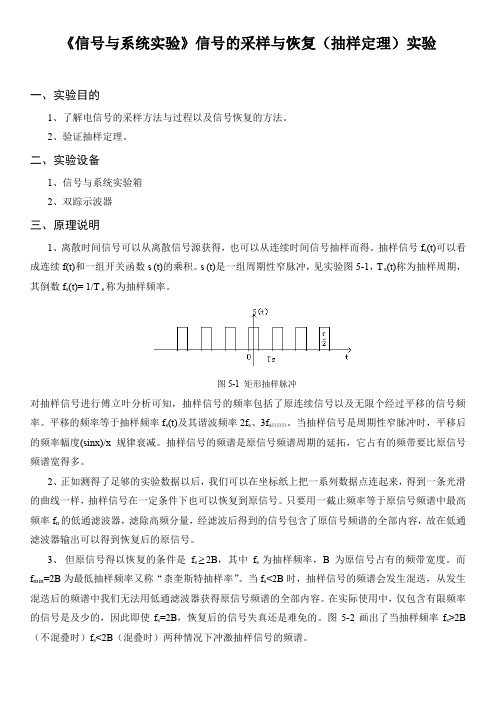
《信号与系统实验》信号的采样与恢复(抽样定理)实验一、实验目的1、了解电信号的采样方法与过程以及信号恢复的方法。
2、验证抽样定理。
二、实验设备1、信号与系统实验箱2、双踪示波器三、原理说明1、离散时间信号可以从离散信号源获得,也可以从连续时间信号抽样而得。
抽样信号f s(t)可以看成连续f(t)和一组开关函数s (t)的乘积。
s (t)是一组周期性窄脉冲,见实验图5-1,T s(t)称为抽样周期,其倒数f s(t)= 1/T s称为抽样频率。
图5-1 矩形抽样脉冲对抽样信号进行傅立叶分析可知,抽样信号的频率包括了原连续信号以及无限个经过平移的信号频率。
平移的频率等于抽样频率f s(t)及其谐波频率2f s、3f s》》》》》》。
当抽样信号是周期性窄脉冲时,平移后的频率幅度(sinx)/x规律衰减。
抽样信号的频谱是原信号频谱周期的延拓,它占有的频带要比原信号频谱宽得多。
2、正如测得了足够的实验数据以后,我们可以在坐标纸上把一系列数据点连起来,得到一条光滑的曲线一样,抽样信号在一定条件下也可以恢复到原信号。
只要用一截止频率等于原信号频谱中最高频率f n的低通滤波器,滤除高频分量,经滤波后得到的信号包含了原信号频谱的全部内容,故在低通滤波器输出可以得到恢复后的原信号。
3、但原信号得以恢复的条件是f s 2,其中f s为抽样频率,为原信号占有的频带宽度。
而f min=2 为最低抽样频率又称“柰奎斯特抽样率”。
当f s<2 时,抽样信号的频谱会发生混迭,从发生混迭后的频谱中我们无法用低通滤波器获得原信号频谱的全部内容。
在实际使用中,仅包含有限频率的信号是及少的,因此即使f s=2 ,恢复后的信号失真还是难免的。
图5-2画出了当抽样频率f s>2 (不混叠时)f s<2 (混叠时)两种情况下冲激抽样信号的频谱。
t f(t)0F()t 0m ωm ω-(a)连续信号的频谱Ts t 0f s (t)F()t0m ωm ω-s ω-s ω()(b)高抽样频率时的抽样信号及频谱 不混叠图5-2 冲激抽样信号的频谱实验中f s >2 、f s =2 、f s <2 三种抽样频率对连续信号进行抽样,以验证抽样定理——要使信号采样后能不失真地还原,抽样频率f s 必须大于信号频率中最高频率的两倍。
信号的抽样与恢复(抽样定理)
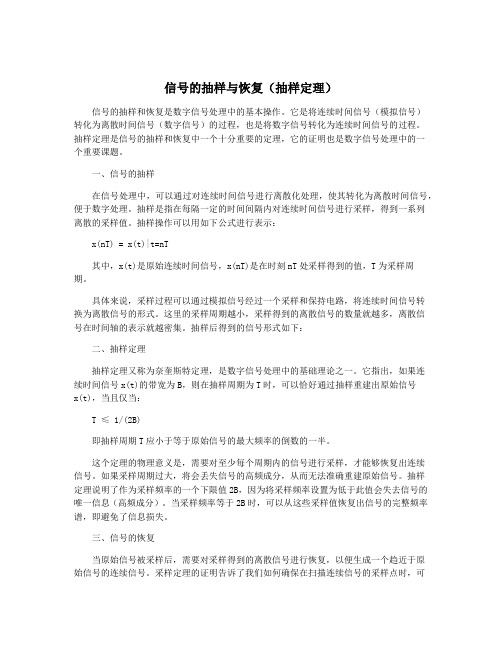
信号的抽样与恢复(抽样定理)信号的抽样和恢复是数字信号处理中的基本操作。
它是将连续时间信号(模拟信号)转化为离散时间信号(数字信号)的过程,也是将数字信号转化为连续时间信号的过程。
抽样定理是信号的抽样和恢复中一个十分重要的定理,它的证明也是数字信号处理中的一个重要课题。
一、信号的抽样在信号处理中,可以通过对连续时间信号进行离散化处理,使其转化为离散时间信号,便于数字处理。
抽样是指在每隔一定的时间间隔内对连续时间信号进行采样,得到一系列离散的采样值。
抽样操作可以用如下公式进行表示:x(nT) = x(t)|t=nT其中,x(t)是原始连续时间信号,x(nT)是在时刻nT处采样得到的值,T为采样周期。
具体来说,采样过程可以通过模拟信号经过一个采样和保持电路,将连续时间信号转换为离散信号的形式。
这里的采样周期越小,采样得到的离散信号的数量就越多,离散信号在时间轴的表示就越密集。
抽样后得到的信号形式如下:二、抽样定理抽样定理又称为奈奎斯特定理,是数字信号处理中的基础理论之一。
它指出,如果连续时间信号x(t)的带宽为B,则在抽样周期为T时,可以恰好通过抽样重建出原始信号x(t),当且仅当:T ≤ 1/(2B)即抽样周期T应小于等于原始信号的最大频率的倒数的一半。
这个定理的物理意义是,需要对至少每个周期内的信号进行采样,才能够恢复出连续信号。
如果采样周期过大,将会丢失信号的高频成分,从而无法准确重建原始信号。
抽样定理说明了作为采样频率的一个下限值2B,因为将采样频率设置为低于此值会失去信号的唯一信息(高频成分)。
当采样频率等于2B时,可以从这些采样值恢复出信号的完整频率谱,即避免了信息损失。
三、信号的恢复当原始信号被采样后,需要对采样得到的离散信号进行恢复,以便生成一个趋近于原始信号的连续信号。
采样定理的证明告诉了我们如何确保在扫描连续信号的采样点时,可以正确地还原其原始形式。
例如,可以通过插值的方式将采样点之间的值计算出来,从而恢复出连续时间信号。
§3.6--信号抽样与抽样定理(信号抽样-时域抽样定理-连续时间信号的重建--)

所以抽样信号的频谱为
其中, 为抽样角频率, 为抽样间隔 , 为抽样频率,
在时域抽样(离散化)相当于频域周期化
频谱是原连续信号的频谱以抽样角频率为间隔周期地延拓,频谱幅度受抽样脉冲序列的傅立叶系数加权。
(1) 冲激抽样若抽样脉冲是冲激序列,则这种抽样称为冲激抽样或理想抽样。
谢谢大家
二、时域抽样定理
二、时域抽样定理
时域抽样定理的图解:假定信号 f (t)的频谱只占据 的范围,若以间隔 对 f (t)进行抽样,抽样信号 fs (t)的频谱 FS(ω) 是以 ωS 为周期重复,在此情况下,只有满足条件 各频移的频谱才不会相互重叠。这样,抽样信号 fs (t) 保留了原连续信号f (t)的全部信息,完全可以用 fs (t) 唯一地表示 f (t) ,或者说, f (t)完全可以由恢复出 fs (t) 。
§ 3.6 信号抽样与抽样定理
信号抽样也称为取样或采样,是利用抽样脉冲序列 p (t) 从连续信号 f (t) 中抽取一系列的离散样值,通过抽样过程得到的离散样值信号称为抽样信号,用 fs (t) 表示。
一、信号抽样
抽样的原理方框图:
一、信号抽样
连续信号经抽样后变成抽样信号,往往还需要再经量化、编码等步骤变成数字信号。这种数字信号经传输、处理等步骤后,再经过上述过程的逆过程就可连续信号频谱在周期重复过程中,各频移的频谱将相互重叠,就不能从抽样信号中恢复原连续信号。频谱重叠的这种现象称为频率混叠现象。
二、时域抽样定理
在满足抽样定理的条件下,可用一截止频率为 的理想低通滤波器,即可从抽样信号 fs(t) 中无失真恢复原连续信号 f (t) 。
三、连续时间信号的重建
因为所以,选理想低通滤波器的频率特性为若选定 ,则有理想低通滤波器的冲激响应为若选 ,则而冲激抽样信号为
实验四 信号抽样与调制解调
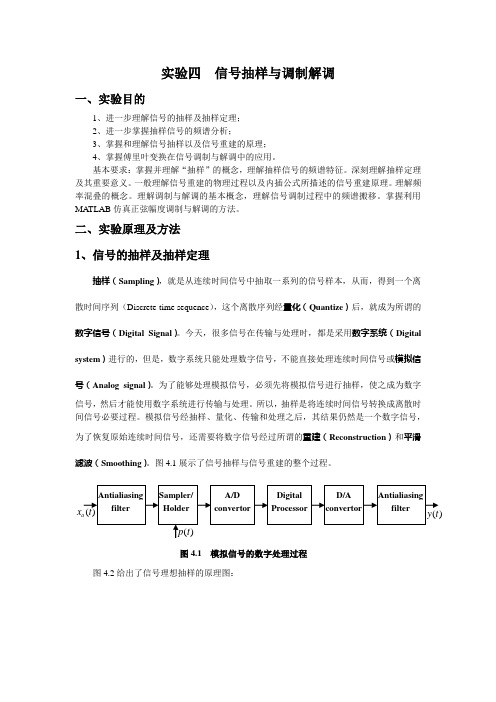
实验四 信号抽样与调制解调一、实验目的1、进一步理解信号的抽样及抽样定理;2、进一步掌握抽样信号的频谱分析;3、掌握和理解信号抽样以及信号重建的原理;4、掌握傅里叶变换在信号调制与解调中的应用。
基本要求:掌握并理解“抽样”的概念,理解抽样信号的频谱特征。
深刻理解抽样定理及其重要意义。
一般理解信号重建的物理过程以及内插公式所描述的信号重建原理。
理解频率混叠的概念。
理解调制与解调的基本概念,理解信号调制过程中的频谱搬移。
掌握利用MATLAB 仿真正弦幅度调制与解调的方法。
二、实验原理及方法1、信号的抽样及抽样定理抽样(Sampling ),就是从连续时间信号中抽取一系列的信号样本,从而,得到一个离散时间序列(Discrete-time sequence ),这个离散序列经量化(Quantize )后,就成为所谓的数字信号(Digital Signal )。
今天,很多信号在传输与处理时,都是采用数字系统(Digital system )进行的,但是,数字系统只能处理数字信号,不能直接处理连续时间信号或模拟信号(Analog signal )。
为了能够处理模拟信号,必须先将模拟信号进行抽样,使之成为数字信号,然后才能使用数字系统进行传输与处理。
所以,抽样是将连续时间信号转换成离散时间信号必要过程。
模拟信号经抽样、量化、传输和处理之后,其结果仍然是一个数字信号,为了恢复原始连续时间信号,还需要将数字信号经过所谓的重建(Reconstruction )和平滑滤波(Smoothing )。
图4.1展示了信号抽样与信号重建的整个过程。
图4.2给出了信号理想抽样的原理图:图4.1 模拟信号的数字处理过程x上图中,假设连续时间信号是一个带限信号(Bandlimited Signal ),其频率范围为m m ωω~-,抽样脉冲为理想单位冲激串(Unit Impulse Train ),其数学表达式为:∑∞∞--=)()(s nT t t p δ 4.1由图可见,模拟信号x(t)经抽样后,得到已抽样信号(Sampled Signal )x s (t),且:)()()(t p t x t x s = 4.2将p(t)的数学表达式代入上式得到:∑∞∞--=)()()(s s s nT t nT x t x δ 4.3显然,已抽样信号x s (t) 也是一个冲激串,只是这个冲激串的冲激强度被x(nT s ) 加权了。
信号与系统抽样与抽样定理

连续时间系统的频率响应
连续信号通过系统响应的频域分析
无失真系统与理想低通
抽样与抽样定理
调制与解调
连续时间信号的时域抽样
信号抽样的理论分析 时域抽样定理
抽样定理的工程应用
信号重建
实际应用举例
1、信号抽样的理论分析
f (t)
fs (t)
T (t)
冲激串 ->序列
f [k ]
2p F T t T
n
w nw
s
f s (t ) f (t ) T (t )
1 2p F FS jw [ F jw 2p T
n
w nw ]
s
1 Fs ( jw ) F [ j(w nws )] T n
wm 0 wm
w
ws 1.5wm
Fs ( jw )
1 T
混叠 (aliasing)
F[j(wws)] ...
ws ws wm
F(jw)
0
F[ j(w ws )] ...
ws
wm ws
w
2、时域取样定理
若带限信号f(t)的最高角频率为ωm,则信号f(t) 可以用等间隔的抽样值唯一地表示。而抽样间隔T 需不大于1/2fm,或最低抽样频率fs不小于2fm。
例5-9 已知实信号f(t)的最高频率为fm (Hz), 试计算对各信号f(2t), f(t)f(2t), f(t)f(2t) 抽样不混叠的最小抽样频率。 解: 根据信号时域与频域的对应关系及抽样定理得: 对信号f(2t)抽样时,最小抽样频率为 4fm(Hz); 对f(t)f(2t)抽样时,最小抽样频率为 2fm(Hz); 对f(t)f(2t)抽样时,最小抽样频率为 6fm(Hz)。
抽样信号与抽样定理

? b0 a0
离散系统的转移算子
r(k ) ? H ( S )e(k )
例2:画出下面差分方程的模拟图
y(k ? 2) ? a1 y(k ? 1) ? a2 y(k) ? b2e(k ? 2) ? b1e(k ? 1) ? b0e(k)
分析:
H (s) ?
y(k ) ? e(k )
b2 S 2 ? b1S ? b0 S 2 ? a1S ? a0
0
FT
Fs (? )
1
Ts
t
??
0
?
特点:理想抽样后的频谱,是将连续信号的频谱进行周 期延拓,延拓的周期是采样频率
三 香农抽样定理
设f(t)是一个带限信号,在|? |> ? m时,F(j? )=0。如果抽 样频率? s>2 ? m ,其中? s =2? /Ts , 那f(t) 就唯一地由其样 本 fs(t)所确定。
差分方程阶数:差分方程的阶定义为响应最大移序与最小移 序之差;
初始条件:解差分方程也必须有初始条件,初始条件的个 数必须等于差分方程的阶数;
线性时不变系统:与连续时间系统中的结论相似,可以用一 个常系数差分方程描述。
数值解:因为差分方程可以很方便地用计算机求其数 值解,所以很多微分方程可以近似为差分方程 求近似数值解。
分析:假设y(k)代表第k个月兔子的总对数,则:
? 老兔子
y(k
?
? 老兔子
2)? ?
新生儿
y(k
?
1)? ?
新生儿
y(k )
解:y(k+2)=y(k)+y(k+1)
y(k+2)-y(k+1)- y(k)=0 y(k)-y(k-1)- y(k-2)=0
信号的采样与恢复(采样定理)

实验六 信号的抽样与恢复实验报告光信二班一、 实验目的(1)了解电信号的采样方法与过程以及信号恢复的方法。
(2)验证抽样定理。
二、 实验原理(1)离散时间信号可以从离散信号源获得,也可以从连续时间信号抽样而得。
抽样信号f ()s t 可以看成连续信号()f t 和一组开关函数()s t 是一组周期形窄脉冲,见图2-9-1,s T 称为抽样周期,其倒数1s sf T 称抽样频率。
对抽样信号进行傅里叶分析可知,抽样信号的频率包括了原连续信号以及无限个经过平移的原信号频率。
平移的频率等于抽样频率f ()s t 及其谐波频率2s f 、3s f ….。
当抽样信号是周期性窄脉冲时,平移后的频率幅度按(sin )x x规律衰减。
抽样信号的频谱是原信号频谱周期的延拓,它占有的频带要比原信号频谱宽得多。
(2)正如测得了足够的实验数据以后,我们 可以在坐标纸上把一系列数据点连起来,得到一条光滑的曲线一样,抽样信号在一定条件下也可以恢复到原信号。
只要用一截止频率等于原信号频谱中最高频率n f 的低通滤波器,滤除高频分量,经滤波后得到的信号包括了原信号频谱的全部内容,故在低通滤波器输出可以得到恢复后的原信号。
(3)还原信号得以恢复的条件是2s m f f ≥,其中s f 为抽样频率,m f 为原信号的最高频率。
而min 2m f f =为最低抽样频率,又称“奈斯特抽样率”。
当2s m f f <时,抽样信号的频谱会发生混叠,从发生混叠后的频谱中无法用低通滤波器获得原信号频谱的全部内容。
在实际使用中,仅包含有限频率的信号是极少的。
因此即使min 2m f f =,回复后的信号失真还是难免的。
图2-9-2画出了当抽样频率2s m f f ≥(不混叠时)及当抽样频率2s m f f <(混叠时)两种情况下冲激抽样信号的频谱。
实验中选用2s m f f <,min 2m f f =,2s m f f ≥三种抽样频率对连续信号进行抽样,以验证抽样定理——要使信号采样后能不失真地还原,抽样频率s f 必须大于信号频率中最高频率的两倍。
§3.6 信号抽样与抽样定理(信号抽样,时域抽样定理,连续时间信号的重建 )

一、信号抽样
信号抽样也称为取样或采样,是利用抽样脉冲序列 p (t) 从连续信号 f (t) 中抽取一系列的离散样值,通过抽样过程得到的离散样值信号 称为抽样信号,用 fs (t) 表示。
f (t)
o
t
p(t)
o TS
t
fs (t)
o TS
t
一、信号抽样
抽样的原理方框图:
Pn
E
Ts
Sa( ns
2
)
则抽样信号的频谱为
Fs ()
E
Ts
Sa( ns
n
2
)F (
ns )
在矩形脉冲抽样情况下,抽样信号频谱也是周期重复,但在重复过
程中,幅度不再是等幅的,而是受到周期矩形脉冲信号的傅立叶系
数 的加权。
一、信号抽样
f (t)
o
p(t)
t
E
o Ts
t
fs (t)
相
乘
o Ts
一、信号抽样
假设原连续信号 f (t)的频谱为 F(ω),即 f (t) F ()
抽样脉冲 p (t) 是一个周期信号,它的频谱为
p(t) Pne jns t P() 2 Pn ( ns )
n
n
其中,s
2
Ts
为抽样角频率,Ts
为抽样间隔 ,
f频 谱s 谱以T是抽1s 原样为连角抽续频样信率频为号率的间,频隔
会相互重叠。这样,抽样信号 fs (t) 保留了原连续信号f (t)的全部信息, 完全可以用 fs (t) 唯一地表示 f (t) ,或者说, f (t)完全可以由恢复出 fs (t) 。 如果 s 2m ,那么原连续信号频谱在周期重复过程中,各频移的频
信号抽样及抽样定理
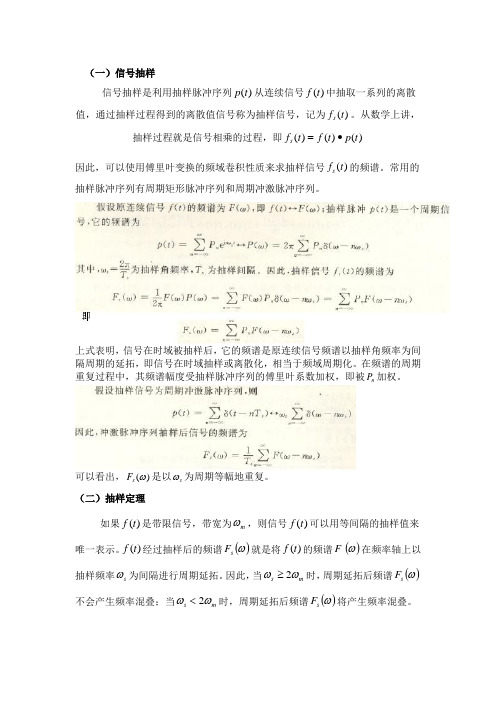
(一)信号抽样信号抽样是利用抽样脉冲序列)(t p 从连续信号)(t f 中抽取一系列的离散值,通过抽样过程得到的离散值信号称为抽样信号,记为)(t f s 。
从数学上讲,抽样过程就是信号相乘的过程,即)()()(t p t f t f s ∙=因此,可以使用傅里叶变换的频域卷积性质来求抽样信号)(t f s 的频谱。
常用的抽样脉冲序列有周期矩形脉冲序列和周期冲激脉冲序列。
上式表明,信号在时域被抽样后,它的频谱是原连续信号频谱以抽样角频率为间隔周期的延拓,即信号在时域抽样或离散化,相当于频域周期化。
在频谱的周期重复过程中,其频谱幅度受抽样脉冲序列的傅里叶系数加权,即被n P 加权。
可以看出,)(ωs F 是以s ω为周期等幅地重复。
(二)抽样定理 如果)(t f 是带限信号,带宽为m ω,则信号)(t f 可以用等间隔的抽样值来唯一表示。
)(t f 经过抽样后的频谱()ωs F 就是将)(t f 的频谱()ωF 在频率轴上以抽样频率s ω为间隔进行周期延拓。
因此,当m s ωω2≥时,周期延拓后频谱()ωs F 不会产生频率混叠;当m s ωω2<时,周期延拓后频谱()ωs F 将产生频率混叠。
通常把满足抽样定理要求的最低抽样频率)2,2(2πωπωm m s s m s f f f f ===称为奈奎斯特频率,把最大允许的抽样间隔ms s f f T 211==称为奈奎斯特间隔。
(三)信号重建 抽样定理表明,当抽样定理小于奈奎斯特间隔时,可以使用抽样信号唯一表示原信号,即信号的重建。
为了从频谱中无失真的恢复原信号,可以采用截止频率为m c ωω≥的理想低通滤波器。
上式表明连续信号可展开为抽样函数()t Sa 的无穷级数,该级数的系数为抽样值。
利用MATLAB 中的函数tt t c ππ)sin()(sin =来表示()t Sa ,所以可获得由()s nT f 重建()t f 的表达式,即()()()⎪⎭⎫ ⎝⎛-=∑+∞=-∞=s c n n s c s nT t c nT f T t f πωπωsin。
信号的抽样与恢复(抽样定理)
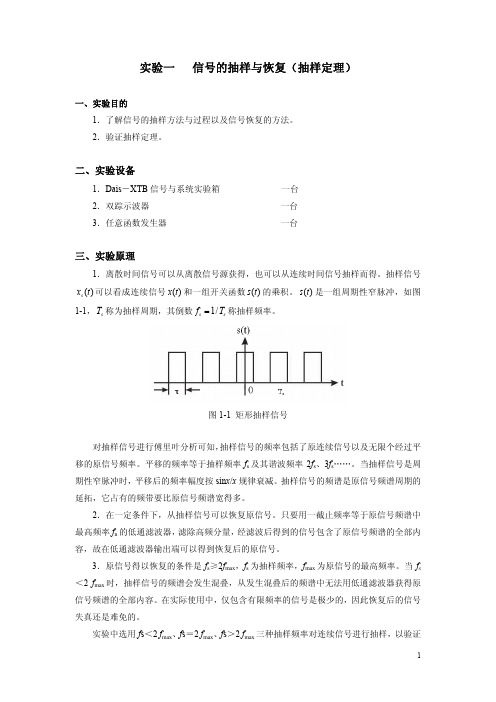
实验一 信号的抽样与恢复(抽样定理)一、实验目的1.了解信号的抽样方法与过程以及信号恢复的方法。
2.验证抽样定理。
二、实验设备1.Dais -XTB 信号与系统实验箱 一台 2.双踪示波器 一台 3.任意函数发生器 一台三、实验原理1.离散时间信号可以从离散信号源获得,也可以从连续时间信号抽样而得。
抽样信号()s x t 可以看成连续信号()x t 和一组开关函数()s t 的乘积。
()s t 是一组周期性窄脉冲,如图1-1,s T 称为抽样周期,其倒数1/s s f T =称抽样频率。
图1-1 矩形抽样信号对抽样信号进行傅里叶分析可知,抽样信号的频率包括了原连续信号以及无限个经过平移的原信号频率。
平移的频率等于抽样频率f s 及其谐波频率2f s 、3f s ……。
当抽样信号是周期性窄脉冲时,平移后的频率幅度按sin x /x 规律衰减。
抽样信号的频谱是原信号频谱周期的延拓,它占有的频带要比原信号频谱宽得多。
2.在一定条件下,从抽样信号可以恢复原信号。
只要用一截止频率等于原信号频谱中最高频率f n 的低通滤波器,滤除高频分量,经滤波后得到的信号包含了原信号频谱的全部内容,故在低通滤波器输出端可以得到恢复后的原信号。
3.原信号得以恢复的条件是f s ≥2f max ,f s 为抽样频率,f max 为原信号的最高频率。
当f s <2 f max 时,抽样信号的频谱会发生混叠,从发生混叠后的频谱中无法用低通滤波器获得原信号频谱的全部内容。
在实际使用中,仅包含有限频率的信号是极少的,因此恢复后的信号失真还是难免的。
实验中选用f s <2 f max 、f s =2 f max 、f s >2 f max 三种抽样频率对连续信号进行抽样,以验证抽样定理。
4.连续信号的抽样和抽样信号的复原原理框图如图1-2所示。
除选用足够高的抽样频率外,常采用前置低通滤波器来防止原信号频谱过宽而造成抽样后信号频谱的混迭,但这也会造成失真。
抽样信号与抽样定理.
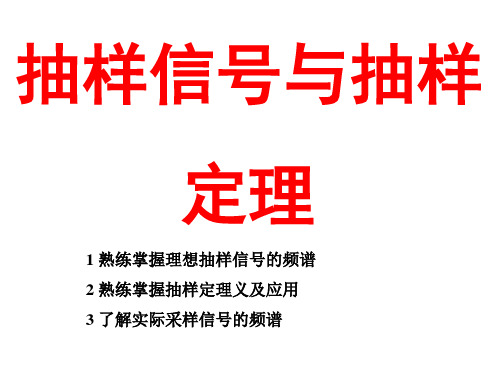
2抽样频率必须进一步增加,一般取的3~5倍。
3)抽样也是一个线性处理过程.
Fs ( )
不满足抽样定理时 产生频率混叠现象
s 0 s
五、频域抽样后的时间函数
F ( )
IFT
0
1
f (t )
1
0
( )
(1)
IFT
1
0
1
相 乘 卷 积
T1
1
0
1
T (t ) 1
老兔子 老兔子 y(k 1)新生儿 y( k 2)
新生儿 y( k )
解:y(k+2)=y(k)+y(k+1) y(k+2)-y(k+1)- y(k)=0 y(k)-y(k-1)- y(k-2)=0 前向 差分 后向 差分
差分方程:y(k+2)-y(k+1)- y(k)=0 差分方程阶数:差分方程的阶定义为响应最大移序与最小移 序之差; 初始条件:解差分方程也必须有初始条件,初始条件的个 数必须等于差分方程的阶数; 线性时不变系统:与连续时间系统中的结论相似,可以用一 个常系数差分方程描述。 数值解:因为差分方程可以很方便地用计算机求其数 值解,所以很多微分方程可以近似为差分方程 求近似数值解。
0
t
T--采样间隔,Ω=2/Ts为抽样频率。
0
t
二 理想抽样的傅立叶变换
f (t )
1
F ( )
0
T (t )
t t
0
m
( n)
0
0
f s (t )
f1 ( t ) f 2 ( t )
0
t
应用MATLAB实现信号抽样及抽样定理课程设计 (2)
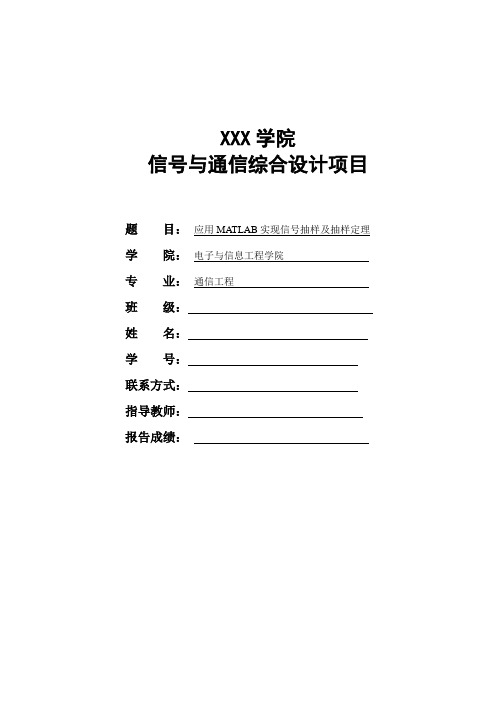
XXX学院信号与通信综合设计项目题目:应用MATLAB实现信号抽样及抽样定理学院:电子与信息工程学院专业:通信工程班级:姓名:学号:联系方式:指导教师:报告成绩:摘要抽样定理是通信理论中的一个重要定理,是模拟信号数字化的理论依据,包括时域抽样定理和频域抽样定理两部分。
采样过程所应遵循的规律,又称取样定理、抽样定理。
采样定理说明采样频率与信号频谱之间的关系,是连续信号离散化的基本依据。
通过MATLAB对抽样定理进行实验仿真验证,得到实验目的的结果。
关键词:频率;抽样定理;目录一、课程设计目的 (2)二、实验设备及环境 (2)三、实验原理 (2)四、实验内容 (3)4.1正弦信号的抽样: (3)4.2混合信号的抽样: (3)4.3实现效果 (3)实验心得 (9)参考文献 (11)一、课程设计目的学会利用MATLAB 完成信号取样及对取样信号的频谱进行分析;学会利用MATLAB 改变取样间隔,观察取样后信号的频谱变化;利用MATLAB,仿模信号抽样与恢复系统的实际实现,探讨过抽样和欠抽样的信号以及抽样与恢复系统的性能。
二、实验设备及环境Pc 机(win10)MATLAB2017a三、实验原理抽样定理:设时间连续信号f(t),其最高截止频率为fm ,如果用时间间隔为 T≤1/2fm 的开关信号对f(t)进行抽样时,则f(t)就可被样值信号唯-地表示。
在一个频带限制在(0, fn)内的时间连续信号f(t),如果以小于等于1/fh 的时间间隔对它进行抽样,那么根据这些抽样值就能完全恢复原信号。
或者说,如果-一个连续信号f(t)的频谱中最高频率不超过fh 这种信号必定是个周期性的信号,当抽样频率fs ≥2fn 时,抽样后的信号就包含原连续信号的全部信息,当需要时,可以根据这些抽样信号样本来还原原来的连续信号。
时域抽样定理:一个频谱受限的信号f(t),如果频谱只占据-wm~+wm 的范围,则信号f(t)可以用等间隔的抽样值惟一地表示。
抽样定理
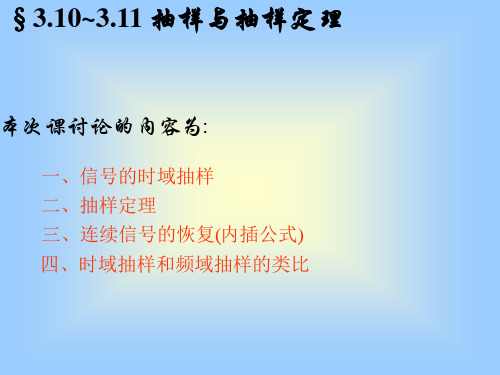
E Fs ( ) Ts 上式表明:
n s Sa( ) F ( n s ) 2 抽样性 周期性 n
信号在时域被抽样后,它的频谱 Fs () 是连续信 号的频谱 F () 以取样角频率 s 为间隔周期地重复 而得到的。在重复过程中,幅度被取样脉冲p(t)的 傅立叶系数所加权,加权系数取决于取样脉冲序列 的形状。 (p152 图3-50)
F ()
1
Fs ()
Es
-m
m
w
抽样后频谱
抽样前频谱
m
s
由以上推导可知,当抽样脉冲为矩形抽样脉冲时, 幅度以Sa函数的规律变化。从 Fs ()的频谱图可见 抽样后的信号频谱包括有原信号的频谱以及无限个 经过平移的原信号的频谱,平移的频率为抽样频率 及其各次谐波频率。且平移后的频谱幅值随频率而 呈Sa函数分布。但因矩形脉冲占空系数很小,所以 其频谱所占的频带几乎是无限宽。
§3.10~3.11 抽样与抽样定理
本次课讨论的内容为 :
一、信号的时域抽样 二、抽样定理 三、连续信号的恢复(内插公式) 四、时域抽样和频域抽样的类比
一. 取样的目的及所遇到的问题
模 拟 信 号 输 入
模 拟
抽 样
量 化
数字信号 处理器
信 号 输 出
A/ D 转换器
D/ A 转换器
数字信号处理系统简单框图
E n s dt Sa Ts 2
1 p( ) 2 Pn ( n s ) Fs ( ) F ( ) * p ( ) 2 n
E Fs ( ) Ts
理想取样
n s Sa F ( n s ) 2 n
上式表明:由于冲激序列的傅立叶系数Pn为常数, 所以 F () 是以 s 为周期等幅地重复,如下图所示:
通信原理实验-抽样定理
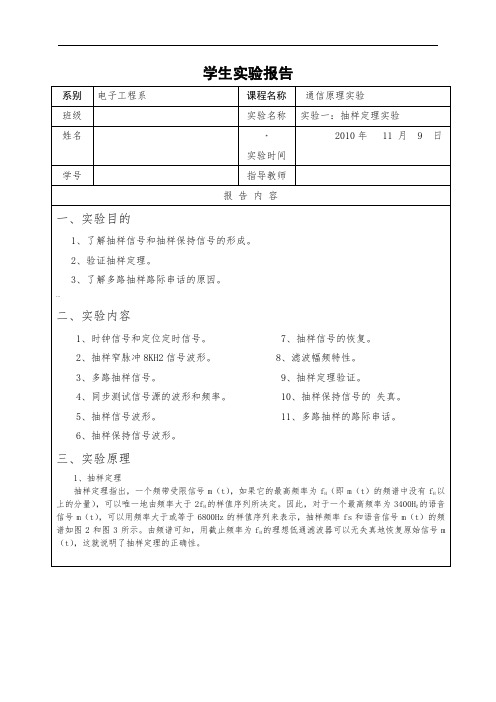
学生实验报告)实际上,考虑到低通滤波器特性不可能理想,对最高频率为3400Hz的语言信号,通常采用8KHz 抽样频率,这样可以留出1200Hz的防卫带。
见图4。
如果fs<fH,就会出现频谱混迭的现象,如图5所示。
在验证抽样定理的实验中,我们用单一频率fH的正弦波来代替实际的语音信号。
采用标准抽样频率fs=8KHZ。
改变音频信号的频率fH,分别观察不同频率时,抽样序列和低通滤波器的输出信号,体会抽样定理的正确性。
验证抽样定理的实验方框图如图6所示。
在图8中,连接(8)和(14),就构成了抽样定理实验电路。
由图6可知。
用一低通滤波器即可实现对模拟信号的恢复。
为了便于观察,解调电路由射随、低通滤波器和放大器组成,低通滤波器的截止频率为3400HZ2、多路脉冲调幅系统中的路际串话~多路脉冲调幅的实验方框图如图7所示。
在图8中,连接(8)和(11)、(13)和(14)就构成了多路脉冲调幅实验电路。
分路抽样电路的作用是:将在时间上连续的语音信号经脉冲抽样形成时间上离散的脉冲调幅信号。
N路抽样脉冲在时间上是互不交叉、顺序排列的。
各路的抽样信号在多路汇接的公共负载上相加便形成合路的脉冲调幅信号。
本实验设置了两路分路抽样电路。
多路脉冲调幅信号进入接收端后,由分路选通脉冲分离成n路,亦即还原出单路PAM信号。
图7 多路脉冲调幅实验框图冲通过话路低通滤波器后,低通滤波器输出信号的幅度很小。
这样大的衰减带来的后果是严重的。
但是,在分路选通后加入保持电容,可使分路后的PAM信号展宽到100%的占空比,从而解决信号幅度衰减大的问题。
但我们知道平顶抽样将引起固有的频率失真。
PAM信号在时间上是离散的,但是幅度上趋势连续的。
而在PAM系统里,PAM信只有在被量化和编码后才有传输的可能。
本实验仅提供一个PAM系统的简单模式。
3、多路脉冲调幅系统中的路标串话路际串话是衡量多路系统的重要指标之一。
路际串话是指在同一时分多路系统中,某一路或某几路的通话信号串扰到其它话路上去,这样就产生了同一端机中各路通话之间的串话。
信号与系统§3.06 信号抽样与抽样定理

信号与系统
二、时域抽样定理
f (t) F(ω)
0
t fs (t)
(a) 连 信 的 谱 续 号 频
−ωm
0
ωm
F (ω) s
ω
0Ts
t
−ωs
−ω m
0
ωm
ωs
fs (t) (b)
ω
高 样 率 抽 信 的 谱 抽 速 时 样 号 频
F (ω) s
0 Ts
t
−ωs
0
ωm ωs
ω
(c) 低 样 率 抽 信 的 谱 频 混 抽 速 时 样 号 频 及 谱 叠
n=−∞ −∞
∞
∞
fs (t )
fs (t) = f (t) ⋅ p(t) = ∑ f (nTs )δ (t − nTs )
抽样脉冲
Ts 2
n=−∞
∞
抽样信号的频谱 1 1 - jnωs t 是以 ωs 为周期等 冲激序列的傅立叶系数为 P = δ (t)e dt = n Ts Ts Ts 幅地重复 − 2 所以冲激抽样信号的频谱为
n=−∞ n=−∞
∞
∞
在时域抽样(离散化) 在时域抽样(离散化)相当于频域周期化
信号与系统
一、信号抽样
(1) 冲激抽样 若抽样脉冲是冲激序列,则这种抽样称为冲激抽样 理想抽样。 冲激抽样或 若抽样脉冲是冲激序列,则这种抽样称为冲激抽样或理想抽样。
连续信号
f (t )
⊗
δ T (t )
抽样信号
p(t) = ∑δ (t − nTs ) ↔ωs ∑δ (ω − nωs )
ωs ≥ 2ω各频移的频谱才不 m
会相互重叠。这样, 的全部信息, 会相互重叠。这样,抽样信号 fs (t) 保留了原连续信号f (t)的全部信息, 或者说, 完全可以用 fs (t) 唯一地表示 f (t) ,或者说, f (t)完全可以由恢复出 fs
3.2抽样信号的傅里叶变换及抽样定理
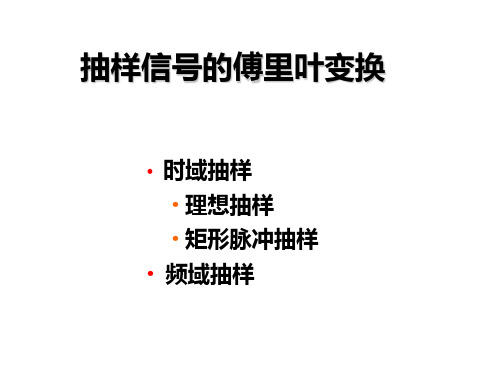
设:
F (ω ) = F [ f (t )]
(−ωm < ω < ωm )
(连续信号 连续信号) 连续信号 (抽样脉冲 抽样脉冲) 抽样脉冲 (抽样信号 抽样信号) 抽样信号 p(t)是周 期信号
P ( ω ) = F [ p ( t )]
Fs (ω ) = F [ f s ( t )]
满足: 满足: f s ( t ) = f ( t ) p ( t )
T 1
t
卷 积
− ω1 0 ω1
ω
− T -tm 0 tm T 1 1
t
抽样定理
时域抽样定理
•
• 频域抽样定理
1、时域抽样定理
惟一地表示。 的范围, 惟一地表示。 的范围,则信号f (t )可用等间隔的抽样值来 1 1 T (ωm = 2π fm ), 其抽样间隔必须不大于 ,即 s ≤ 2 fm 2 fm 或者说最低抽样率为 2 fm。
2.理想抽样(周期单位冲激抽样)
f ( t ) ↔ F (ω ) (−ωm < ω < ωm )
p ( t ) ↔ P (ω )
fs ( t ) ↔ Fs (ω )
p(t ) = δ T (t ) =
n =−∞
∑ δ (t − nT ) ↔ ωs ∑ δ (ω − nωs )
s
∞
∞
n =−∞
f s (t ) = f (t )δ T (t )
根据时域卷积定理
f1(t ) = F−1[F (ω)] = f (t ) ∗δT(t ) = f (t ) ∗ 1 =
∑δ (t − nT1) ω1 n=−∞
1
∞
∑ f (t − nT1) ω1 n=−∞
§3-8抽样信号的傅里叶变换与抽样定理
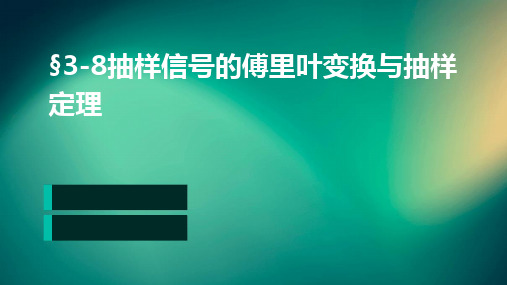
抽样信号的应用场景
抽样信号在数字信号处理中占有重要 地位,广泛应用于音频、视频、通信 等领域。
在视频处理中,通过对模拟视频信号 进行抽样和量化,可以将其转换为数 字视频信号,实现高清、无损的视频 传输和显示。
• 信号必须是带限的:即信号中不包含超过某一特定频率的成分。如果信号不是带限的,那么抽样后可能会导致 混叠现象,即高频成分被错误地识别为低频成分。
• 抽样过程必须是等间隔的:即每次抽样的时间间隔必须相等。如果抽样间隔不相等,那么恢复出的信号可能会 出现失真。
• 恢复滤波器必须是理想的:在实际应用中,由于滤波器的非理想特性,可能会导致恢复出的信号与原始信号存 在一定误差。因此,在设计抽样系统时需要考虑滤波器的性能及其对信号恢复的影响。
目的
通过实验掌握抽样信号的傅里叶变换 及抽样定理的基本原理和实现方法。
要求
能够熟练搭建抽样信号的实验系统, 正确设置实验参数,准确测量和分析 实验结果。
实验环境和设备
环境
实验室应具备良好的电磁屏蔽和接地措 施,避免外部干扰对实验结果的影响。
VS
设备
示波器、信号发生器、频谱分析仪等实验 设备,以及用于数据处理的计算机和相关 软件。
实验步骤和结果分析
01
步骤
02
1. 搭建抽样信号的实验系统,包括信号发生器、抽样电路和示
波器等。
2. 设置信号发生器的输出频率和幅度,产生原始信号。
03
实验步骤和结果分析
3. 通过抽样电路对原 始信号进行抽样,得 到抽样信号。
5. 使用频谱分析仪分 析抽样信号的频谱特 性。
- 1、下载文档前请自行甄别文档内容的完整性,平台不提供额外的编辑、内容补充、找答案等附加服务。
- 2、"仅部分预览"的文档,不可在线预览部分如存在完整性等问题,可反馈申请退款(可完整预览的文档不适用该条件!)。
- 3、如文档侵犯您的权益,请联系客服反馈,我们会尽快为您处理(人工客服工作时间:9:00-18:30)。
1、结合抽样定理,利用MATLAB编程实现信号经过冲激脉冲抽样后得到的抽样信号及其频谱,并利用构建信号,并计算重建信号与原升余弦信号的误差。
解:
wm=2;
wc=1.2*wm;
Ts=1;
dt=0.1;
t1=-10:dt:10;
ft=sinc(t1/pi);
N=5000;
k=-N:N;
W=2*pi*k/((2*N+1)*dt);
n=-100:100;
nTs=n*Ts;
fst=sinc(nTs/pi);
subplot(221);
plot(t1,ft,':'),hold on;
stem(nTs,fst),grid on;
axis([-10,10,-0.4,1.1]);
xlabel('Time(sec)'),ylabel('fs(t)');
title('Sa(t)抽样后信号'),hold off,
Fsw=Ts*fst*exp(-j*nTs'*W);
subplot(222);
plot(W,abs(Fsw)),grid on;
axis([-20 20 0 4]);
xlabel('\omega'),ylabel('Fs(w)');
title('Sa(t)抽样信号频谱');
t=-10:dt:10;
f=fst*Ts*wc/pi*sinc((wc/pi)*(ones(length(nTs),1)*t-nTs'*ones(1,length(t))));
subplot(223);
plot(t,f),grid on;
axis([-10 10 -0.4 1.1]);
xlabel('t'),ylabel('f(t)');
title('重建新号');
error=abs(f-ft);
subplot(224);
plot(t,error),grid on
xlabel('t'),ylabel('error(t)');
title('误差');
2、结合抽样定理,利用MATLAB编程实现升余弦信号
经过冲激脉冲抽样后得到的抽样信号及其频谱,并利用构建升余弦信号,并计算重建信号与原升余弦信号的误差。
解:
wm=2;
wc=1.2*wm;
Ts=1;
dt=0.1;
t1=-10:dt:10;
ft=((1+cos(t1))/2).*(heaviside(t1+pi)-heaviside(t1-pi));
N=5000;
k=-N:N;
W=2*pi*k/((2*N+1)*dt);
n=-100:100;
nTs=n*Ts;
fst=((1+cos(nTs))/2).*(heaviside(nTs+pi)-heaviside(nTs-pi));
subplot(221);
plot(t1,ft,':'),hold on;
stem(nTs,fst),grid on;
axis([-10,10,-0.4,1.1]);
xlabel('Time(sec)'),ylabel('fs(t)');
title('Sa(t)抽样后信号'),hold off,
Fsw=Ts*fst*exp(-j*nTs'*W);
subplot(222);
plot(W,abs(Fsw)),grid on;
axis([-20 20 0 4]);
xlabel('\omega'),ylabel('Fs(w)');
title('Sa(t)抽样信号频谱');
t=-10:dt:10;
f=fst*Ts*wc/pi*sinc((wc/pi)*(ones(length(nTs),1)*t-nTs'*ones(1,length(t)))); subplot(223);
plot(t,f),grid on;
axis([-10 10 -0.4 1.1]);
xlabel('t'),ylabel('f(t)');
title('重建新号');
error=abs(f-ft);
subplot(224);
plot(t,error),grid on
xlabel('t'),ylabel('error(t)');
title('误差');。
